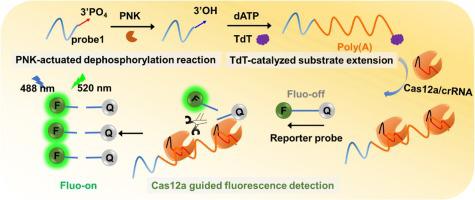Sensors and Actuators B: Chemical ( IF 8.0 ) Pub Date : 2020-12-16 , DOI: 10.1016/j.snb.2020.129317 Xiaolong Zhang , Cheng Zheng , Lei Ding , Yanni Wu , Haipo Xu , Yupeng Sun , Yongyi Zeng , Xiaolong Liu , Jingfeng Liu

|
Polynucleotide kinase (PNK) is an important DNA damage repair-related enzyme and also a promising therapeutic target in various diseases. Here, we developed a dual amplified sensing strategy based on the combination of terminal deoxynucleotidyl transferase (TdT) and CRISPR-Cas12a for high selective and sensitive detection of PNK activity in cell lysates and also inhibitor screening. In this sensing system, the PNK converted the 3′-phosphate DNA to 3′-hydroxy DNA, and then the TdT catalyzed to add a long poly-adenine (poly (A)) at the 3′−OH terminus DNA (as first amplified step). The produced poly (A) tail acted as activator to trigger the Cas12a trans-cleavage (non-target) activity to cleave reporter probes for fluorescence detection (as second amplified step). The dual amplified steps lead to a synergetic signal amplification effect for sensitive detection of PNK activity. The developed sensing platform enable detect PNK activity with linear range from 0 to 1 U/mL and a direct detection limit of 5 × 10−4 U/mL. It was also successfully used for PNK inhibitor screening and PNK activity detection in cell extracts even at a single-cell level. The efficient dual amplified method can broaden the CRISPR/Cas-based sensing systems in other bio-/chem-analysis fields.
中文翻译:

CRISPR-Cas12a结合末端脱氧核苷酸转移酶介导的等温扩增,可灵敏检测多核苷酸激酶活性
多核苷酸激酶(PNK)是一种重要的DNA损伤修复相关酶,也是各种疾病中有希望的治疗靶标。在这里,我们开发了基于末端脱氧核苷酸转移酶(TdT)和CRISPR-Cas12a的双重扩增传感策略,用于细胞裂解液中PNK活性的高选择性和灵敏检测以及抑制剂的筛选。在该传感系统中,PNK将3'-磷酸DNA转换为3'-羟基DNA,然后TdT催化在3'-OH末端DNA上添加一个长的聚腺嘌呤(poly(A))(首先是放大步骤)。产生的聚(A)尾巴用作激活剂来触发Cas12a反式-切割(非目标)活性,以切割报告探针进行荧光检测(作为第二个扩增步骤)。双重扩增步骤导致协同信号放大作用,用于灵敏地检测PNK活性。开发的传感平台能够检测PNK活性,线性范围为0到1 U / mL,直接检测极限为5×10 -4 U / mL。即使在单细胞水平,它也已成功用于细胞提取物中的PNK抑制剂筛选和PNK活性检测。高效的双重扩增方法可以在其他生物/化学分析领域扩展基于CRISPR / Cas的传感系统。































 京公网安备 11010802027423号
京公网安备 11010802027423号